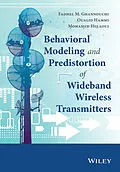Covers theoretical and practical aspects related to the behavioral modelling and predistortion of wireless transmitters and power amplifiers. It includes simulation software that enables the users to apply the theory presented in the book. In the first section, the reader is given the general background of nonlinear dynamic systems along with their behavioral modelling from all its aspects. In the second part, a comprehensive compilation of behavioral models formulations and structures is provided including memory polynomial based models, box oriented models such as Hammerstein-based and Wiener-based models, and neural networks-based models. The book will be a valuable resource for design engineers, industrial engineers, applications engineers, postgraduate students, and researchers working on power amplifiers modelling, linearization, and design.
Autorentext
Fadhel M. Ghannouchi University of Calgary, Canada
Oualid Hammi King Fahd University of Petroleum and Minerals, Saudi Arabia
Mohamed Helaoui University of Calgary, Canada
Klappentext
Behavioral Modeling and Predistortion of Wideband Wireless Transmitters covers theoretical and practical aspects related to the behavioral modeling and predistortion of wireless transmitters and power amplifiers. It includes simulation software that enables the users to apply the theory presented in the book. In the first section, the reader is given the general background to nonlinear dynamic systems along with their behavioral modeling from all aspects. In the second part, a comprehensive compilation of behavioral models formulations and structures is provided, including memory polynomial based models, box oriented models such as Hammerstein-based and Wiener-based models, and neural networks-based models. The later chapters focus on practical applications of the theory and knowledge presented earlier on, together with a thorough description of practical approaches for power amplifiers characterization, behavioral model identification, and digital predistortion. Advanced topics such as joint quadrature impairments compensation and digital predistortion, as well as digital predistortion of MIMO, and concurrent multiband systems are covered in the last chapter. The book will be a valuable resource for design engineers, industrial engineers, applications engineers, postgraduate students, and researchers working on power amplifier modeling, linearization, and design.
Key features:
- Covers all the aspects related to behavioral modeling of power amplifiers from experiments to model validation
- Provides a software tool that allows the reader to practically apply most of the models presented in the book to model real power amplifiers
- Written by experts in the field with cumulative experience of more than 40 years in academia and industry
Inhalt
About the Authors xi
Preface xiii
Acknowledgments xv
1 Characterization of Wireless Transmitter Distortions 1
1.1 Introduction 1
1.1.1 RF Power Amplifier Nonlinearity 2
1.1.2 Inter-Modulation Distortion and Spectrum Regrowth 2
1.2 Impact of Distortions on Transmitter Performances 6
1.3 Output Power versus Input Power Characteristic 9
1.4 AM/AM and AM/PM Characteristics 10
1.5 1 dB Compression Point 12
1.6 Third and Fifth Order Intercept Points 15
1.7 Carrier to Inter-Modulation Distortion Ratio 16
1.8 Adjacent Channel Leakage Ratio 18
1.9 Error Vector Magnitude 19
References 21
2 Dynamic Nonlinear Systems 23
2.1 Classification of Nonlinear Systems 23
2.1.1 Memoryless Systems 23
2.1.2 Systems with Memory 24
2.2 Memory in Microwave Power Amplification Systems 25
2.2.1 Nonlinear Systems without Memory 25
2.2.2 Weakly Nonlinear and Quasi-Memoryless Systems 26
2.2.3 Nonlinear System with Memory 27
2.3 Baseband and Low-Pass Equivalent Signals 27
2.4 Origins and Types of Memory Effects in Power Amplification Systems 29
2.4.1 Origins of Memory Effects 29
2.4.2 Electrical Memory Effects 30
2.4.3 Thermal Memory Effects 33
2.5 Volterra Series Models 38
References 40
3 Model Performance Evaluation 43
3.1 Introduction 43
3.2 Behavioral Modeling versus Digital Predistortion 43
3.3 Time Domain Metrics 46
3.3.1 Normalized Mean Square Error 46
3.3.2 Memory Effects Modeling Ratio 47
3.4 Frequency Domain Metrics 48
3.4.1 Frequency Domain Normalized Mean Square Error 48
3.4.2 Adjacent Channel Error Power Ratio 49
3.4.3 Weighted Error Spectrum Power Ratio 50
3.4.4 Normalized Absolute Mean Spectrum Error 51
3.5 Static Nonlinearity Cancelation Techniques 52
3.5.1 Static Nonlinearity Pre-Compensation Technique 52
3.5.2 Static Nonlinearity Post-Compensation Technique 56
3.5.3 Memory Effect Intensity 59
3.6 Discussion and Conclusion 61
References 62
4 Quasi-Memoryless Behavioral Models 63
4.1 Introduction 63
4.2 Modeling and Simulation of Memoryless/Quasi-Memoryless Nonlinear Systems 63
4.3 Bandpass to Baseband Equivalent Transformation 67
4.4 Look-Up Table Models 69
4.4.1 Uniformly Indexed Loop-Up Tables 69
4.4.2 Non-Uniformly Indexed Look-Up Tables 70
4.5 Generic Nonlinear Amplifier Behavioral Model 71
4.6 Empirical Analytical Based Models 73
4.6.1 Polar Saleh Model 73
4.6.2 Cartesian Saleh Model 74
4.6.3 Frequency-Dependent Saleh Model 76
4.6.4 Ghorbani Model 76
4.6.5 Berman and Mahle Phase Model 77
4.6.6 ThomasWeidnerDurrani Amplitude Model 77
4.6.7 Limiter Model 78
4.6.8 ARCTAN Model 79
4.6.9 Rapp Model 81
4.6.10 White Model 82
4.7 Power Series Models 82
4.7.1 Polynomial Model 82
4.7.2 Bessel Function Based Model 83
4.7.3 Chebyshev Series Based Model 84
4.7.4 Gegenbauer Polynomials Based Model 84
4.7.5 Zernike Polynomials Based Model 85
References 86
5 Memory Polynomial Based Models 89
5.1 Introduction 89
5.2 Generic Memory Polynomial Model Formulation 90
5.3 Memory Polynomial Model 91
5.4 Variants of the Memory Polynomial Model 91
5.4.1 Orthogonal Memory Polynomial Model 91
5.4.2 Sparse-Delay Memory Polynomial Model 93
5.4.3 Exponentially Shaped Memory Delay Profile Memory Polynomial Model 95
5.4.4 Non-Uniform Memory Polynomial Model 96
5.4.5 Unstructured Memory Polynomial Model 97
5.5 Envelope Memory Polynomial Model 98
5.6 Generalized...
